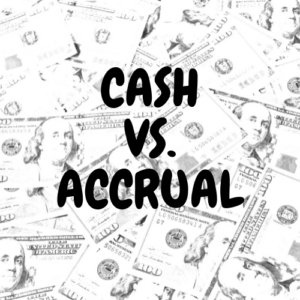5 Financial Topics all Association Professionals Must Understand
By Rachel Luoma, MS, CAE
If you have read any of my previous blogs, then you may see a theme amongst many of them – financials. Since I was a little kid, numbers just made sense to me. There was a correct answer and an incorrect answer and, more importantly, a reason why the correct answer was the correct answer.
Having worked in associations for almost two decades (wow, typing that makes me feel really old), I have noticed some common themes that all association management professionals should understand.
Below is some general information about each along with links to learn more if you are a math nerd like me.
- Cash Versus Accrual Accounting
Before I started working in associations, I assumed that most people managed their finances by recording income when it was received and expenses when they were paid. I didn’t know this was called cash accounting; I just assumed that everyone managed their money this way.
As I got more involved in association management, however, I learned more about the two accounting methods – cash accounting and accrual accounting. Each association is required to determine their method of how they record revenue and expenses.
Cash Accounting involves recording income once it hits the bank and expenses once it leaves the bank. Basically, you only record money when you get it. This method doesn’t utilize accounts payable or accounts receivable because money is only recorded when it comes in or goes out.
only record money when you get it. This method doesn’t utilize accounts payable or accounts receivable because money is only recorded when it comes in or goes out.
Accrual accounting involves recording the income when it is earned and expenses when they are billed – regardless of when the money is actually received. Interestingly, the standards outlined by the generally accepted accounting principles (GAAP) require the use of accrual accounting, outlining that this method provides a clearer picture of the overall finances.
To learn more about the difference between cash accounting and accrual accounting, QuickBooks offers this great blog https://quickbooks.intuit.com/r/bookkeeping/cash-vs-accrual-accounting-whats-best-small-business/.
Regardless of which method your association uses, it is important to have a fundamental understanding of both methods to ensure that the association’s financials are being reported in accordance with the selected method.
- Financial Statements
The association financial statement includes two primary components, the balance sheet (also referred to as the statement of position) and the income statement (also referred to as the profit and loss statement). Some, associations, may also have a cash flow statement. For the purpose of today’s blog I am going to only focus on the first two.
The balance sheet provides a snapshot of the financial position of the association at a specific point in time. It outlines the assets, liabilities and equity owned by the association. I like to think of this as…if we closed our doors tomorrow, what assets would the association have (money, building, equipment, etc.) and what liabilities would the association owe (deferred revenue, loans, scholarships, etc.).
The income statement provides more detailed information on the operations of the association. This includes showing the revenue, expenses, and profits (or losses) of the association. Some associations include a cash flow statement in with their financial statements which shows how the cash moves in and out of the association.

The financial statements are critical to understanding the financials of the association. A good association professional not only understands these financial components, but can communicate these to volunteer leadership.
Check out my other blog, Fun with Financials at https://yoursearchisdone.com/fun-with-financials/ for more on understanding and reviewing financial statements.
- Budget Preparation
Associations are just like any business. They have to have financial stability to ensure they can deliver their programs and services to constituents. A budget is a critical component of financial stability as it is essentially a spending plan for the organization. It outlines projected revenue and projected expenses for the fiscal year.
It outlines projected revenue and projected expenses for the fiscal year.
It is important for any association professional to know how to read an association budget – especially in the association they work for, to help ensure they are following the plan.
Learn more about budgets in my previous blog post at https://yoursearchisdone.com/budgets-its-all-about-the-benjamins/.
- 990s
The IRS Form 990 is a tax form that most associations file annually to report their financial information, governance information and activities to the IRS. It is a critical piece of the puzzle to justify to the IRS that the organization should continue to maintain its tax-exempt status.
While most associations work with an outside accounting firm or CPA to produce and file their Form 990, it is still important for all association professionals to have a general understanding of what the 990 form contains. Furthermore, association professionals at an executive level should know how to review their association’s Form 990 to ensure the information presented is correct before it is filed.
Learn more about how to review your association’s 990 at https://yoursearchisdone.com/how-to-review-your-associations-990/.
- Financial Policies
Associations run on good governance. This includes the articles of incorporation, the bylaws, the policies, and the procedures. Policies are developed by the board and are recorded in the minutes. Policies can be about the organization and typically outline how something within the organization (or external to the organization) should be handled. They provide guidance to the volunteer leadership and to staff. 
Examples might include policies on who can sign checks, how reserve funds must be handled, how long certain documents must be maintained and more.
Some of the most critical policies an association can have relate to conflict of interest, whistleblower, document retention and destruction, compensation and joint ventures. These are all policies that are listed on the IRS Form 990. More information on these policies can be found at https://yoursearchisdone.com/precision-policies-can-protect-your-associationnon-profit/.
At the end of the day, associations are just like any business; financial management is critical to its success. This means that on a regular basis, you have to report and review the finances with your volunteer leadership and any committees that may have oversight regarding the finances of the association. As such, all association professionals must have a general understanding of the financial principles outlined in this blog. Happy financial management everyone!

– Rachel has been involved in associations for over 15 years and has experience in all areas of association management. She holds a Master’s Degree in Adult Education and holds the Certified Association Executive designation. Rachel was named a Young and Aspiring Professional by Association Trends Magazine, Executive of the Year by the Florida Society of Association Executives and was recognized as one of Association Forum’s and USAE’s Forty Under 40® Awards recipients. She is a former Chair of the Florida Society of Association Executives. Fun Fact(s): When she’s not doing her association management thing, Rachel rocks out as lead singer with Tallahassee’s hottest cover band – Suckerdust!




